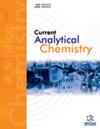Metal-organic Frameworks: Emerging Luminescent Sensors
IF 1.7
4区 化学
Q3 CHEMISTRY, ANALYTICAL
引用次数: 0
Abstract
: Metal-organic frameworks (MOFs), a crystalline material, are a new type of inorganicorganic hybrid material. MOFs are of great interest to researchers in chemistry and material science due to their various chemical and physical properties, and features include their remarkable surface area, high porosity, flexibility, structural variety, flexibility, extreme porosity, a large surface area, augmented adsorption/desorption kinetics, biocompatibility and functional tunability. MOFs are multi-dimensional crystals and have extended net-like frameworks from molecular building units such as inorganic metal nodes and organic linkers. The structurally diverse MOFs have found applications in chemical sensing and several other fields, such as energy applications, biomedicine, and catalysis. Numerous researchers from other fields have been drawn to this topic by the intrinsic potential to absorb gas molecules, which has led to the applications of gas storage and heterogeneous catalysis. Because of their low framework density, open metal sites for interaction, adjustable pore size, fast response with high sensitivity and selectivity, and real-time monitoring, luminescent metalorganic frameworks, or LMOFs, have piqued the interest of a large scientific community as a promising candidate for sensor applications. A number of characteristics, including non-toxicity, biodegradability, and reasonably priced, varied functionality, are important factors in the use of MOFs in chemo- and biosensing. MOFs can be very promising candidates as selective and sensitive chemosensors for the detection of cations, anions, small molecules, gases and explosives. In this manuscript, we address recent research advances in the use of metal-organic-framework-based luminescent sensors for detecting some small molecules and various metal ions in aqueous biological and environmental samples. A wide range of materials may be reached in the emerging field of synthetic and material chemistry, thanks to the capacity to change the pore size and chemically functionalize its nature without changing its architecture金属有机框架:新兴发光传感器
:金属有机框架(MOFs)是一种晶体材料,是一种新型的无机杂化材料。MOFs 具有多种化学和物理性质,其显著的比表面积、高孔隙率、柔韧性、结构多样性、灵活性、极高的孔隙率、大比表面积、增强的吸附/解吸动力学、生物相容性和功能可调性等特点,引起了化学和材料科学研究人员的极大兴趣。MOFs 是多维晶体,由无机金属节点和有机连接体等分子构建单元扩展而成的网状框架。结构多样的 MOFs 已在化学传感和其他一些领域(如能源应用、生物医学和催化)找到了应用。许多其他领域的研究人员都被 MOFs 吸收气体分子的内在潜力所吸引,从而将其应用于气体储存和异相催化。发光金属有机框架(LMOFs)具有框架密度低、开放的金属相互作用位点、孔径大小可调、反应速度快、灵敏度和选择性高以及可实时监测等特点,因此作为传感器应用的理想候选材料,引起了广大科学界的兴趣。MOFs 具有多种特性,包括无毒性、生物可降解性、价格合理、功能多样,这些都是将其用于化学和生物传感的重要因素。MOFs 作为选择性灵敏化学传感器,在检测阳离子、阴离子、小分子、气体和爆炸物方面大有可为。在本手稿中,我们将介绍利用基于金属有机框架的发光传感器检测水性生物和环境样品中某些小分子和各种金属离子的最新研究进展。在新兴的合成化学和材料化学领域,由于可以在不改变结构的情况下改变孔隙大小并对其性质进行化学功能化,因此可以使用多种材料。
本文章由计算机程序翻译,如有差异,请以英文原文为准。
求助全文
约1分钟内获得全文
求助全文
来源期刊

Current Analytical Chemistry
化学-分析化学
CiteScore
4.10
自引率
0.00%
发文量
90
审稿时长
9 months
期刊介绍:
Current Analytical Chemistry publishes full-length/mini reviews and original research articles on the most recent advances in analytical chemistry. All aspects of the field are represented, including analytical methodology, techniques, and instrumentation in both fundamental and applied research topics of interest to the broad readership of the journal. Current Analytical Chemistry strives to serve as an authoritative source of information in analytical chemistry and in related applications such as biochemical analysis, pharmaceutical research, quantitative biological imaging, novel sensors, and nanotechnology.
 求助内容:
求助内容: 应助结果提醒方式:
应助结果提醒方式:


